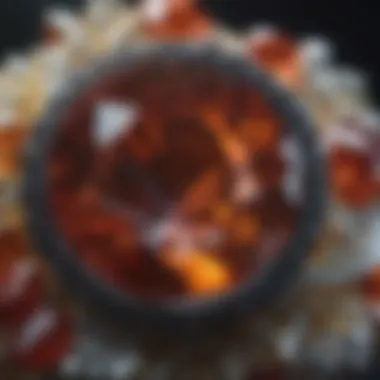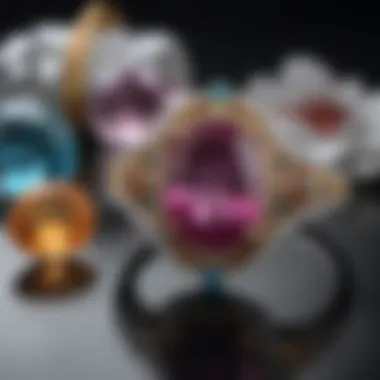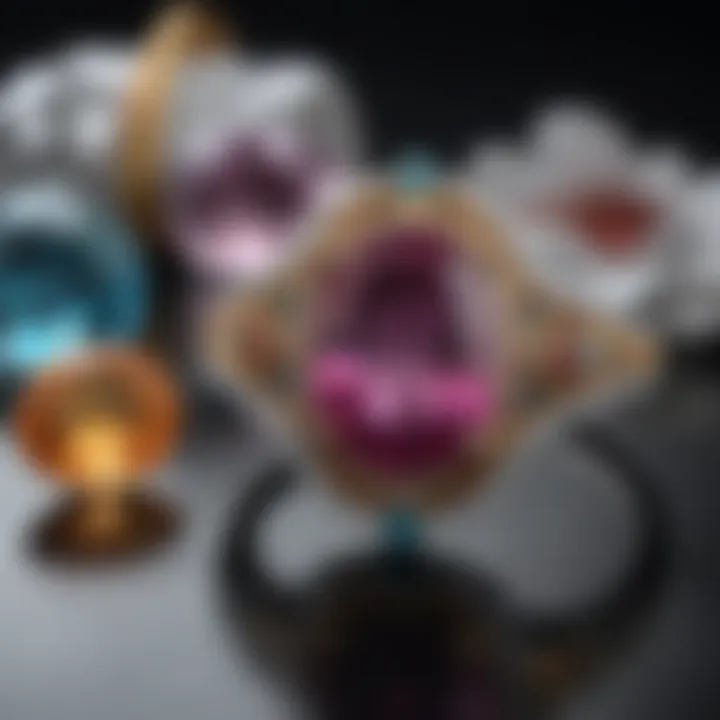Exploring Gemstone Names and Their Meanings


Intro
Gemstones have always held a certain fascination for humanity. Their shimmering beauty and palpable presence can evoke feelings of wonder and admiration. However, beneath that sparkling exterior lie stories, meanings, and historical significance that have contributed to their allure over centuries. This exploration is not just about colors and cuts; it’s about understanding why certain stones resonate with us and how they have been revered across cultures.
When we refer to gemstones, we are not merely speaking of decorative elements used in jewelry. These stones have been embedded in the fabric of human history. To fully appreciate their value, it’s crucial to dive deeper into their names and meanings, deciphering the messages inherent in each unique mineral. For collectors and designers, having this knowledge can enrich their creations or collections, while also enhancing the connection to the stones they use.
In this guide, we will unravel the intricacies of gemstones. We will consider their classification, delve into their historical significance, and uncover the myths that surround them. Along the way, we will provide insights that can benefit both enthusiasts and seasoned professionals in the gemstone arena. By the end, readers will not only have a better understanding of gemstone meanings but also the wisdom to appreciate these treasures on a more profound level.
Gemstone Overview
Definition and Characteristics
Gemstones are defined as precious or semi-precious minerals that are cut and polished for use in jewelry or decoration. Each stone possesses a unique set of characteristics: hardness, clarity, color, and carat weight, all of which contribute to its value and appeal. Understanding these characteristics can significantly influence the way a gemstone is perceived and appreciated.
One of the words that often comes to mind when discussing gemstones is "hardness". This property determines how susceptible a gemstone is to scratches and wear. The Mohs scale, for instance, ranks minerals based on their hardness, helping buyers understand durability against everyday use.
Classification of Gemstones
Gemstones can be classified into broad categories based on their mineral composition and origin. The two main classes are:
- Precious gemstones: These include diamonds, rubies, emeralds, and sapphires. These are often more expensive and regarded for their rarity and beauty.
- Semi-precious gemstones: Amethyst, aquamarine, garnet, and opal, for example, fall into this category. While still valuable, they tend to be more abundant and affordable.
Furthermore, gemstones are categorized by their mineral families, which can help enthusiasts understand the lineage and relationships between different stones. For instance, all types of garnets belong to the garnet family, united by shared characteristics.
Important Note: Understanding classifications not only aids in selection but also highlights the connections between different stones. This can enrich one's appreciation manifold.
Historical Significance
Ancient Uses and Cultural Importance
Gemstones have served various purposes throughout history, from adorning royalty to being used in traditional medicine. Ancient civilizations often ascribed specific meanings and properties to gemstones. For instance, the ancient Egyptians valued turquoise for its protective qualities, often using it in amulets for good fortune. Similarly, cultures in Asia considered jade to symbolize virtue and morality.
Exploring these historical uses can reveal astonishing insights into how our ancestors perceived the natural world and the enduring beliefs that continue to shape modern interpretations of gemstones.
Myths and Legends Surrounding Gemstones
Myths and stories surrounding gemstones further illustrate their significance. Take, for example, the legendary tale of the Hope Diamond, purported to bring misfortune to its owners. Conversely, the rose quartz is often hailed as a stone of love, encouraging harmony in relationships.
These tales enrich the narrative fabric of gemstones, suggesting that each stone carries more than just aesthetic beauty; they exhibit a rich tapestry of cultural heritage.
By understanding these themes, we cultivate a deeper appreciation for gemstones that extend beyond their mere visual attributes, opening the door to a more nuanced understanding of their meanings and values.
Preamble to Gemstone Nomenclature
When one steps into the realm of gemstones, they quickly realize the sheer importance of names assigned to each stone. The initial impression of a gemstone often arises from its name, hinting at the beauty, lore, and functionality within the stone itself. Understanding gemstone nomenclature allows enthusiasts and collectors to explore not just the physical properties of gems but also their cultural and metaphysical significance. This section aims to shed light on how names help frame our understanding of gemstones, facilitating a more profound appreciation for these natural wonders.
Understanding Gemstone Classification
Gemstones are typically classified based on a combination of factors including their chemical composition, crystal structure, and physical properties. The jewelers and geologists categorize them into broad groups like precious and semi-precious stones. However, classification isn't merely a scientific exercise; it plays a substantial role in how we perceive and value these gems. For instance, diamonds, rubies, sapphires, and emeralds have long been considered precious due to their rarity and beauty, which has sparked endless fascination across cultures and ages. The specific nomenclature used in gemstone classification can also pave the way for discussions about rarity, market prices, and even investment potential.
Moreover, it’s crucial to consider aspects like color variation, clarity, and carat weight. For example, sapphires aren't limited to just the traditional blue; they can exhibit a vibrant array of colors, each called by unique names—pink sapphires, yellow sapphires, and so forth.
A few essential classifications include:
- Natural Gemstones: These are formed through natural processes and usually have certain value owing to their rarity.
- Synthetic Gemstones: Man-made stones like synthetic rubies and sapphires mimic their natural counterparts closely but are typically less expensive.
- Organic Gemstones: These arise from biological processes, with pearls being the most notable example.
Recognizing these classifications highlights the underlying intricacies of gemstone nomenclature, which ultimately aids in better understanding their beauty and significance.
The Role of Names in Gem Culture
The names associated with gemstones are more than just labels—they carry history, mystery, and specific cultural ties. For ages, names have been believed to embody the very essence of a gemstone, encapsulating its qualities and the stories that surround it. The etymology of names often reflects their origins, beauty, and historical significance. For instance, the term "emerald" comes from the Greek word smaragdus, which means green. Such names serve to transport one to different cultures and eras, revealing how these stones were appreciated and utilized across time.
In many cultures, particular stones are assigned meanings based on their colors or properties. Take the case of the amethyst, traditionally believed to impart wisdom and clarity of thought, derived from the Greek root words that signify non-intoxication. Names can also denote associations—like how rubies, linked with royalty and passion, are often dubbed "the king of gemstones."
Names also play a crucial role in commerce. For a collector or designer, the name can make a significant difference in market value. When someone mentions "African emerald," a distinct image and value proposition springs to mind, setting it apart from lesser-known variants. The name, in this sense, becomes a powerful marketing tool.
"Names are not just identifiers; they encapsulate cultural significance and historical narratives, enabling a deeper connection with gemstones."
Historical Context of Gemstone Names


The historical context of gemstone names is not merely an academic pursuit; it’s a journey into the soul of our civilization. Each gemstone carries tales of mystical beliefs, lavish desires, and ancient lore. For enthusiasts, collectors, and craftsmen alike, understanding this background can offer a profound connection to the stones that adorn our jewelry and spaces. The names assigned to these stones often reflect attributes that different cultures have imbued them with over time, revealing a tapestry of meanings that span epochs and geographies.
The importance of this topic in the article cannot be overstated. Gemstone names are portals to eras gone by, a compass guiding us through the rich narratives of our past. They are not arbitrary; rather, they encapsulate many factors from metaphysical attributes to societal values. As we peel back the layers of history behind each name, we discover insights that enhance our appreciation and understanding of the gemstones themselves.
Ancient Civilizations and Gemstones
From the ancient Egyptians who enshrined lapis lazuli in their tombs, to the Greeks considering amethyst a safeguard against drunkenness, gemstones have played pivotal roles in cultures throughout history. The name lapis lazuli itself translates to ‘blue stone,’ highlighting its revered position as a symbol of the heavens and divinity. In this regard, its deeper meaning ran parallel with the afterlife, thus reinforcing its value in both funerary practices and adornment of the living.
- Ancient Greeks also held love for emeralds, which they referred to as smaragdus, meaning green. Associated with rebirth and fertility, the emerald had a particular spot in their mythology. It was believed that the goddess Venus had an emerald that lent its hue to the earth during the springtime.
- Furthermore, gemstones such as diamonds have transcended their status as mere adornments. Known as the hardest natural substance, diamond was once called adamas in ancient Greece, symbolizing invincibility. Their shimmering brilliance not only served as a sign of wealth but also manifested the hope of power and strength—a meaning that resonates deeply today.
The gems utilized by these civilizations were not just for decoration; they were believed to possess powers that could influence fate or even heal ailments. This notion laid the groundwork for later understandings of gemstones in medicine and magic, a theme that continues to capture imaginations even in modern times.
Cultural Significance in Different Societies
Across the globe, gemstone nomenclature often echoes cultural values and spiritual beliefs. For instance, in Hindu traditions, certain stones are revered as sacred and are directly linked to deities. The ruby, known as manik in Sanskrit, is believed to represent the sun and is associated with the heart and the soul. Thus, it embodies both love and vitality.
Similar stories unfold in Native American traditions, where turquoise is not merely a beautiful stone but a protector and symbol of harmony. The name turquoise itself comes from the French term for Turkish stone, reflecting its journey along trade routes that connected disparate cultures.
“Gemstones are not just beautiful; they stand as testaments to our shared humanity.”
In contrast, the showcases the earthy associations found in gemstones like quartz. Quartz was held in high esteem as a stone of prophecy, often used in rituals aimed at connecting the ethereal with the physical realm. Its name, originating from the Old English cweorþ, emphasizes clarity and insight, hinting at its role in enhancing perception and wisdom.
This cultural richness is what makes gemstones much more than objects of beauty. They exist within a lexical matrix of emotions, beliefs, and values passed down through generations. The names we now use encapsulate the depth of experience associated with each stone, reflecting the hopes, aspirations, and fears of those who came before us. Their meanings serve as a bridge connecting the present community of gem enthusiasts with those ancient civilizations that started it all.
Common Gemstone Types and Their Meanings
Understanding different types of gemstones and their meanings plays a significant role in appreciating their value and significance in various cultures. Gemstones, with their varied colors and qualities, are more than just beautiful objects; they each carry unique stories and symbolic meanings that can enhance their allure. By diving into the characteristics, historical context, and various uses of these stones, enthusiasts can make informed choices when buying jewelry, collecting, or even gifting gemstones.
Quartz: The Universal Stone
Characteristics of Quartz
Quartz is probably one of the most abundant and recognized minerals. Its most notable feature is its incredible versatility, showcasing a wide range of colors and forms. Clear, smoky, and rose quartz are just a few variations, each having its own set of attributes. This stone's distinctive crystalline structure is often admired, making it a popular choice for both jewelry and decorative items.
One key aspect is its durability, which makes it a favorable pick in the creation of various pieces of jewelry that not only need to look good but also withstand daily wear. Another unique feature of quartz is its piezoelectric properties, meaning it can generate an electric charge under pressure. This quality opens up opportunities for practical uses beyond aesthetics, such as in electronics and watches.
Symbolism and Uses
The symbolism attached to quartz is vast. Often regarded as a master healer, quartz is believed to amplify energy and intention. Many practitioners use it in meditation and healing practices, making it popular among spiritual communities. Its significance in various cultures adds to its importance; some factions consider it a purification stone.
Additionally, quartz has diverse applications in various fields. It's not just for crystal healing; its beauty makes it suitable for jewelry, while its properties allow for uses in high-tech industries. With quartz, one isn't just investing in a stone; it's investing in a tool known for its multifaceted roles.
Sapphire: The Stone of Wisdom
Properties and Color Variations
Sapphire is renowned for its royal blue hue, but this gem isn't limited to just one color. Sapphires can arise in virtually every color of the rainbow, excluding red—that hue is labeled ruby. The strong crystal structure of sapphires makes them hardy gems, suitable for daily wear. This specific aspect contributes remarkably to their popularity as engagement ring stones; their durability promises longevity.
The color variations often denote different meanings. For example, pink sapphires evoke feelings of love and compassion, while yellow sapphires are thought to attract wealth. Such diversity in properties makes sapphires appealing to a broad audience looking for various emotional and symbolic significances.
Historical Reverence
Historically, sapphires have held a revered place across cultures. They were once believed to have protective qualities, regarded as a safeguard against envy and harm. Royalty particularly favored sapphires, with many crowns adorned with these sparkling stones, symbolizing wisdom, nobility, and divine favor.
Many cultures, including ancient Greeks and Persians, associated sapphires with the heavens, which ties back to their color and the belief that wearing them could bring divine blessings. This historical reverence not only underscores their status but also highlights why these gems continue to be cherished and sought after today.
Emerald: The Gem of Love
Growth Patterns and Origins
Emeralds come from the beryl family, and their rich green color captivates the hearts of many. Their growth requires specific conditions, often forming in metamorphic rocks, which makes them relatively rare. The formation of inclusions is common in emeralds, often called 'jardin,' or garden, which does not detract from their value as with other stones but rather adds character.
Emeralds are often sourced from Colombia, but there are also significant mines in Brazil and Zambia. This geographical difference can affect the stone's clarity and color saturation, with Colombian versions typically more prized for their vivid hue and transparency.
Cultural Associations
Emeralds have held a cherished place in various cultures for centuries. In ancient Egypt, they were revered as symbols of fertility and rebirth, often buried with pharaohs. Likewise, in Indian traditions, emeralds symbolize love and faithfulness, making them popular choices for wedding and engagement gifts.
These cultural associations accentuate the unique attribute of emeralds as tokens of love and loyalty, further establishing them as emotional stones that strengthen relationships.
Ruby: The Blood of the Heart


Unique Attributes
Rubies boast a stunning crimson color that symbolizes love and passion. Their unique chemical composition, primarily composed of corundum, provides an intense hue and exceptional hardness, establishing them as one of the hardest gemstones next to diamonds. This makes rubies incredibly attractive not only for their beauty but also for their resilience in jewelry.
Besides their visual appeal, the color of the ruby carries significant weight; deeper reds are more sought after, often reflecting the stone's quality and value. This rich color, along with its rarity, often leads to high pricing and desirability.
Meaning Across Cultures
Across civilizations, rubies have been associated with powerful meanings. In the East, they are often linked to protection and prosperity, with legends suggesting they can bring good fortune to their owners. Conversely, in the Western context, rubies represent love and desire, often given as tokens of romantic commitment.
This varied interpretation across cultures adds depth to the ruby, illustrating its role in fashioning emotional connections and sentiments linked to love.
Opal: The Stone of Transformation
Color Play and Significance
Opals are undoubtedly unique due to their ability to display an extraordinary play-of-color. This phenomenon occurs due to their internal structure, which refracts light in varying shades, making them an enchanting choice for gemstone enthusiasts. Opals can be found in a spectrum of colors, including whites, blues, and blacks, each carrying its own charm.
One undeniable benefit of opals is their ability to symbolize transformation and creativity—qualities that many people actively aspire to embody. This distinctive symbolism sets it apart, making opal a favorite among artists and innovators looking for inspiration.
Myths and Legends
Opals are steeped in folklore and tales. In Aboriginal mythology, opals were formed when the creator descended to Earth, leaving behind a vibrant legacy of beauty. Some traditions also associate them with magical powers; wearing an opal is thought to provide protection and promote inspiration.
These myths and legends offer a fascinating layer to the opal’s appeal. Not only do they serve as intriguing conversation starters, but they also invite wearers to tap into their creativity and transformation potential.
Metaphysical Properties of Gemstones
The realm of gemstones extends beyond their physical beauty and geological properties; it embraces a world rich with metaphysical associations. When one thinks about the essence of gemstones, it is essential to consider how their energies are perceived by those who cherish them. These stones are often regarded not merely as decorative items but as powerful tools for personal growth, emotional healing, and energetic balance. In this spectrum of significance, the metaphysical properties of gemstones play a pivotal role, allowing individuals to connect on deeper levels with themselves and their surroundings.
Gemstone enthusiasts frequently delve into how different stones can affect one’s life, offering support, clarity, and transformative experiences. Each type of gemstone is believed to radiate a specific energy frequency, which can align well with the wearer’s needs and intentions. Some might seek a particular stone during moments of stress, while others may opt for different crystals to spark creativity or instill confidence. It is this belief in the transformative capabilities of gemstones that solidifies their importance in the holistic health and wellness communities.
Energy and Healing Properties
One of the most talked-about aspects of gemstones is their purported healing abilities. Many supporters of crystal healing advocate that each stone possesses unique vibrational frequencies that channel different kinds of energy. These vibrations can interact with the human energy field, often referred to as the aura, to promote balance and health.
- Amethyst: Known in many circles for its calming properties, amethyst is often suggested for those dealing with anxiety or emotional turbulence. It is said to promote restful sleep and aid in overcoming negative thought patterns.
- Rose Quartz: Dubbed the stone of love, rose quartz is believed to facilitate connection, both to oneself and others. Many use it to foster self-love and compassion, making it a favorite among those working on personal growth.
- Citrine: Celebrated as a stone of abundance, citrine is often linked to wealth and prosperity. It's thought to inspire joy and warmth, igniting creativity and motivation.
In the hearts and minds of believers, these stones are seen not as just beautiful objects but as companions in one’s journey towards healing. Demonstrating their metaphysical properties becomes essential for those who wish to integrate these natural wonders into their daily lives.
Influence on Emotions and Mindset
Beyond mere physical manifestations, gemstones are also thought to impact emotional health and mental clarity. The influence they wield over emotions can be profound. Whether knowingly or subconsciously, individuals often turn to specific stones to assist in navigating their emotional landscape.
- Lapis Lazuli: This deep blue stone is often associated with wisdom and self-expression. It’s said to aid in communication, making it a perfect companion for those looking to articulate their thoughts and feelings effectively.
- Black Tourmaline: A stone of protection, black tourmaline is frequently utilized to ward off negative energies and promote a sense of grounding. Many people find it helpful for combating stress, anxiety, or sleep disturbances.
- Clear Quartz: As a master healer, clear quartz is seen as a universal stone that can amplify both spiritual growth and emotional healing. Its versatility allows it to be paired with nearly any other stone for enhanced effects.
An often-underestimated aspect is the environment in which these stones reside. Surroundings infused with various gemstones may uplift an entire room's energy, creating a serene space conducive to mindfulness and reflection. More than merely physical adornments, these gemstones can help maintain emotional equilibrium and spark inner transformations.
The truth is, crystals are an ancient tool for enlightenment and self-discovery, allowing the user to access and harness the energies within and around them.
In summary, the metaphysical properties of gemstones are not only fascinating but they also deepen our understanding of how these stones connect to our lives. By exploring their energies, healing capabilities, and emotional influences, we come to appreciate gemstones as significant allies in personal development.
Evaluating Gemstone Value
When it comes to gemstones, understanding their value isn't just about their beauty or popularity; it’s a thorough assessment of various elements that combine to determine their worth. Evaluating gemstone value occupies a crucial space in the broader conversation about gemstones, helping both sellers and buyers alike make informed choices. The value of a gemstone can greatly influence its desirability and collectability, making this section essential for enthusiasts and collectors.
Criteria for Value Assessment
Determining the value of gemstones hinges on several pivotal criteria. Among these, rarity, quality, and the prevailing market demand stand out as key factors that dictate the overall worth of any gemstone.
Rarity and Quality
At the heart of gemstone valuation lies rarity and quality. Rarity refers to how scarce a gemstone is in nature. For example, stones like jadeite are rarely found compared to more common stones like amethyst. This scarcity amplifies their value. The quality relates to the gemstone's characteristics, including clarity, color, cut, and carat weight.
A gemstone that's not only rare but also possesses superior quality, such as a flawless diamond, can command sky-high prices.
- Key Characteristic: Scarcity. The more uncommon a gemstone is, the more sought after it becomes.
- Why It’s Popular: Rare gemstones are often perceived as prestigious and can elevate the status of a piece of jewelry.
- Unique Feature: The combination of unusual beauty and limited supply often draws collectors.
- Advantages: Investing in high-quality, rare gemstones can yield significant returns.
- Disadvantages: The market for rarities can be fickle; not all rare stones hold lasting value.
Market Demand


Alongside rarity and quality, the market demand plays a pivotal role in a gemstone’s valuation. Demand fluctuates based on fashion trends, cultural influences, and economic conditions. For instance, certain colors or cuts may surge in popularity, directly impacting a gemstone's price.
- Key Characteristic: Dynamic shift. The market for gemstones is not static and responds to trends.
- Why It’s Beneficial: Understanding market demand helps investors choose gemstones that are likely to appreciate over time.
- Unique Feature: Trends can often be influenced by celebrity endorsements or societal movements.
- Advantages: A gemstone that meets current demand could quickly increase in value.
- Disadvantages: Investing based on trends can lead to volatility; what is in vogue today may not be tomorrow.
Investment Considerations in Gemstones
Investments in gemstones carry a certain weight, requiring thoughtful consideration. What should you keep an eye out for? First and foremost, ensure authentic certification when buying gemstones, as this can significantly affect resale value. Furthermore, consider the costs associated with storage, maintenance, and potential restorations of gemstones – these can add up.
It’s wise to focus on stones that have proven historical performance in the market rather than merely those that are trendy. Investing in well-regarded gemstones, like high-quality rubies or emeralds, may yield a more steady return than offbeat gemstones that are hot at the moment.
"In the grand scheme of gemstone investment, knowledge is power; the more you know, the better decisions you can make."
Overall, evaluating the value of gemstones is a multi-faceted responsibility, requiring you to navigate through rarity, quality, and market demand to make the most informed choices. Understanding these layers can maximize your appreciation and investment potential in these enchanting treasures.
Practical Care for Gemstones
Taking proper care of gemstones is essential not just for their aesthetic appeal, but also for preserving their inherent value. When you consider that many gemstones can last a lifetime—and even longer when cared for properly—it becomes clear that practical care is a worthwhile endeavor. Even a sturdy gem like a diamond can lose its luster if neglected. This section aims to underscore the necessity of gemstone maintenance and provide actionable insights into cleaning and storage practices that can help you keep your treasures in tip-top shape.
Cleaning and Maintenance Tips
Keeping your gemstones clean is akin to giving them a refreshing spa day, helping to restore sparkle and beauty. However, not all gems are created equal when it comes to cleaning methods. Some stones are durable, while others, like opals or pearls, may be more fragile and require a gentler touch.
Here are some practical steps for cleaning various types of gemstones:
- Warm soapy water: For most hard stones like sapphires and rubies, soaking them in warm, soapy water for a short while can do wonders. Use a soft brush to get into those tiny crevices.
- Ultrasonic cleaners: These devices are a gem's best friend, especially for repairing tarnished metals or dirtied stones. However, exercise caution with porous stones like emeralds that can't handle the vibration well.
- Avoid harsh chemicals: Stay away from bleach and ammonia, as these can cause irreversible damage to some gemstones. Always check the gemstone’s specific cleaning needs.
- Drying: After cleaning, always dry your gems with a soft cloth to avoid water spots. For extra care, use a microfiber cloth for that polished touch.
Storage Practices
How you store your gemstones can significantly affect their longevity and visual appeal. A poor storage method can lead to scratches or chips, while an organized approach can keep them in pristine condition.
Here are some smart storage tips:
- Separate storage: Always store different types of gemstones separately. This prevents harder stones from scratching softer ones. Consider placing them in individual soft pouches or sections of a jewelry box.
- Temperature control: Keep your gemstones in a cool, dry place. Extreme temperatures can cause some stones to crack or lose their color.
- Using boxes or drawers: Invest in a good-quality jewelry box with compartments. Look for boxes with a soft lining to protect the gems. Avoid wooden boxes unless they’re lined with a soft material, as wood can cause scratches.
- Regular check-ups: Make it a habit to periodically check the condition of your gemstones. This helps you catch any potential issues early on, from loose settings to scratches.
"Caring for gemstones goes beyond mere maintenance—it’s an investment in their beauty and longevity."
In summary, practical care for gemstones involves a combination of thoughtful cleaning practices and astute storage solutions. By treating your gems with the care they deserve, you ensure that they remain not just visually stunning but also maintain their value over time.
Future Trends in the Gemstone Market
The gemstone market, often viewed through the lens of luxury and beauty, is gradually evolving amidst new consumer demands and global challenges. Understanding these future trends is not just beneficial for jewelers and collectors but crucial for anyone interested in the broader implications of gemstone sourcing and sustainability. With consumer awareness rising, there's an increasing push for ethically sourced materials and a keen interest in the intersection of technology and gemology.
Sustainability and Ethical Sourcing
As people become more environmentally conscious, the call for sustainable and ethically sourced gemstones has grown louder. This involves ensuring that the extraction, processing, and trading of gemstones don’t exploit workers or harm the environment. The following points highlight the significance of ethical sourcing:
- Consumer Demand: Buyers are more inclined to support brands that demonstrate social responsibility, often choosing stones with verifiable sources.
- Transparency and Certification: Many organizations are developing standards and certifications to guarantee ethically mined gemstones. For instance, the Responsible Jewellery Council (RJC) emphasizes responsible practices in the jewelry supply chain.
- Environmental Impact: Sustainable mining practices aim to minimize landscape disruption and pollution, fostering a healthier planet for future generations.
The importance of these elements cannot be overstated. By selecting ethically sourced gemstones, consumers not only make a positive impact but also drive the industry toward more responsible practices.
Technological Advancements in Gemology
The world of gemology is also witnessing rapid changes thanks to technology. These advancements are reshaping how gemstones are evaluated, marketed, and enjoyed. Here are some notable developments:
- Gemstone Identification: Enhanced laser and imaging technologies allow gemologists to identify gemstones more accurately and efficiently. Innovations such as spectroscopy and tomographic imaging help detect treatments and confirm authenticity.
- Blockchain for Traceability: Some companies are starting to utilize blockchain technology to ensure traceability of gemstones from mine to market. This builds consumer trust as buyers can access verified data about their gemstones’ origins.
- 3D Printing and Design: Jewelers are embracing 3D printing not just for crafting but also for designing unique pieces that highlight the characteristics of each gemstone. This intermingling of design with technical capability is expanding creative avenues in the industry.
The End: The Timeless Allure of Gemstones
In the realm of gemstones, the significance of names transcends mere labels. Their meanings imbue these stones with cultural, historical, and personal value. This article has traversed various facets of gemstone nomenclature, revealing how each stone carries a narrative that invites introspection and reverence.
Understanding these meanings can enrich the experience for enthusiasts, collectors, and designers alike. When selecting a gem, it’s not only its beauty or rarity that counts but also the story it tells. For instance, an emerald's association with love may resonate deeply with someone seeking its potent qualities in a romantic gift.
Moreover, the ecological and ethical considerations around gemstone sourcing have become paramount. The modern buyer often seeks to align values with purchases, making it crucial to understand where and how gemstones are sourced. The choice of a stone might reflect a commitment to sustainability or a preference for ethically mined gems.
Curiosity about gemstones doesn’t merely stem from their physical properties, but from their deeper meanings and the connections we forge with them. As we’ve seen, the same stone can signify varied attributes across cultures, enhancing its allure. Therefore, it’s essential to appreciate gemstones not only as luxuries but as vessels of meaning that connect us to our past and influence our present.
"Gemstones are not just about aesthetic appeal; they're the echoes of history, culture, and emotion."
In the end, every gemstone reveals a unique tale. This exploration has shed light on the intricate interplay of nomenclature and meaning, instilling an appreciation for these natural wonders. The timeless allure of gemstones lies not only in their beauty but also in how they resonate with human experience and aspirations.
Final Thoughts on Gemstone Meanings
As we wrap up this exploration, let’s ponder a few key takeaways about gemstone meanings:
- Cultural Diversity: Each gemstone bears various meanings across cultures, impacting how they are valued and appreciated.
- Personal Connections: Individuals often find personal significance in certain stones, making each choice a form of storytelling.
- Investment in Meaning: Beyond financial investment, acquiring gemstones can represent a commitment to values such as love, fidelity, or healing.
- Legacy and Tradition: Passed down through generations, gemstones carry family stories, often serving as memorable heirlooms.
In closing, gemstones are deeply intertwined with human experience. Recognizing their meanings enriches our interaction with them, fostering a connection that goes beyond aesthetics into the realm of belonging and heritage.







